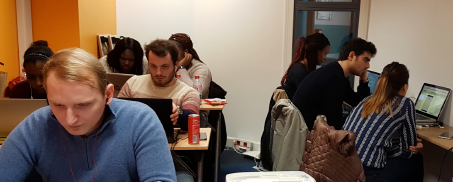App Inventor: Who do we train and from where do we teach ?


 This is a guest blog by MIT Master Trainers Youmna Ovazza and Pierre Huguet.
This is a guest blog by MIT Master Trainers Youmna Ovazza and Pierre Huguet.
App Inventor empowers “normal people to build Apps” that are relevant to their daily life and community. We have a great time teaching with it, Thanks Hal :=)
Lowering access thresholds to computer programming also has impacts on teaching. Normal teachers (English, history, maths, French …) can become mobile CSP teachers! What is it then, that we teach or what is the impact of App Inventor on the way we teach?
Authors, from very different backgrounds (Marketing and Engineering) joined with Design thinking specialists to teach a mobile CSP course to MBA students (see this link). This project-oriented course used a Build-Conceptualize-Customize-Create framework and a flipped classroom mode. Training covered a panel of components (sensors, communication, local and Web databases), then switched to students’ created projects. No student yet intends to become a professional programmer, but all experienced this course as relevant to their curriculum. Most were looking for more!
Merging multidisciplinary views which is often difficult (design, marketing, computational), came out smoothly: students did their own cooking from several teachers’ fields. Over this short course, they experienced practical connections between:
- the hard science view : Turing basis for algorithms, abstraction, event driven programming, Internet architecture, APIs, …
- the design and marketing view: address real-life projects and user relevant issues, search insights, iterate between design and user’s experience,
- the management view : match a goal with short deadline, work in a group with new colleagues, match constraints (limited coding knowledge and access to instructors, …).
We feel that for college and PD training, App Inventor is helpful to break barriers between disciplines that generally stand next to each other ...
What’s next ? Following this first experience, we see the following issues:
1. How can we scale up this course to match classes beyond a hundred students?
There is a request for this as a first week icebreaker for MBA students. Current student/teacher ratio is around 5 to 1. We need to rise to around 15 or 20:1. How can we then provide a similar quality and keep students’ motivation?
Can we also keep student’s involvement which is linked to the short-project or Hackaton like intensity of the course?
Scalability through course design? Part of the answer is to keep with video tutorials and flipped classroom, with teachers as coaches. Some more work is required on pedagogy, using more of App Inventor’s prototyping capabilities and App canvas to deal with complex issues.
2. Data is all over the place:
Sharing data on the web is a key to socially relevant Apps that students want to create. As this course is intended to extend digital literacy of students that will become managers, we also need to address this issue and give a flavor of the data management or the server side.
We will keep moving!

